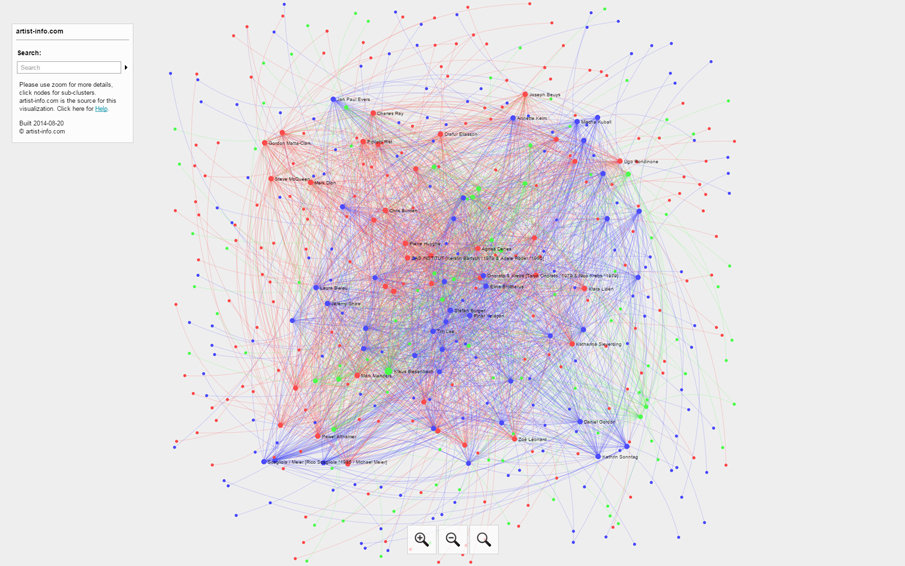To open this example of visualizing a CURATOR-artists network in a new browser window click on the image or here.
Find on our Overview page details on how to best navigate and use all features of the interactive ‘Visualizing Art Networks’ browser windows.
Visualizing Art Networks – CURATOR-artists Example
This CURATOR-artists example for ‘Visualizing Art Networks’ is about curator Klaus Biesenbach and the artists he has selected for some of his shows. All related exhibitions for this insight can be found on curator Klaus Biesenbach’s artist-info page.
For each of the artists connected through networks in this CURATOR-artists point of view an individual analysis with our ARTIST-artists and ARTIST-venues point of view reveals additional important insight to explore and develop valuable connections.
See below how artist-info ‘Visualizing Art Networks’ is unveiling a variety of focuses on specific artists shown by Klaus Biesenbach beyond the selection for specific exhibitions.
They are summarized at the bottom of the page with Benefits.
How to read the visualized networks
CENTER – In this example the center of the visualized networks is the curator Klaus Biesenbach. All queries of artist-info database for the visualized networks are related to this curator.
For Klaus Biesenbach artist-info knows of 13 solo- and 6 group-exhibitions, in museums, and non-profit places, from 1988 – 2015, worldwide.
BEFORE / after – An ordinary curator’s CV would give you a list of these exhibitions and where they took place. They wouldn’t show all the artists or additional curators nor would they reveal the groups of favorite artists, although it is basic information for the curator’s profile.
before / AFTER – artist-info visualizing analytics finds 94 artists related to the 19 solo- and group-exhibitions above mentioned. To list them all in the right side pane click on ‘Klaus Biesenbach’ in the network heap.
The search option on the left helps to find a specific artist among all 94 artists. The search result is listed in the right side pane. Details on how to use the right side pane can be found on our Overview page.
CLUSTERS / SUB-CLUSTERS – Zooming in and selecting with your mouse an artist unfolds the important capacity and value of artist-info ‘Visualizing Art Networks’.
Different to an ordinary CV the artist’s cross-linked exhibition history in artist-info gives you the possibility to look up how the artists are connected through exhibitions among each other.
This makes it possible to find different groups of artists building clusters with the CENTER, Klaus Biesenbach. The clusters are showing not only the relation between Klaus Biesenbach and each of the cluster’s artists but as well how the members of the cluster are connected among each other. Some are more, some less connected and are showing their dominance through the known details like the number of times showing together and the number of etches with other network members.
The list of the cluster’s artists in the right side pane helps to further select sub clusters, identifying (e.g. mouse over), further filtering, and selecting, exploring, discovering, evaluating artists in the network.
More on our Overview page.
PROPAGATION – How to find options for new connections?
The big heap of the starting image is surrounded by single dots at the end of a line / edge. These single dots represent artists who are most likely important new associations as a result of the artist-info algorithm. They have the highest number of exhibitions with the related network cluster member.
To go back to the starting image click on ‘Klaus Biesenbach’ and then on ‘Back’ at top of the right side pane.
It is the first time these amazing relations can be shown and no list or table could give you this overview and insight.
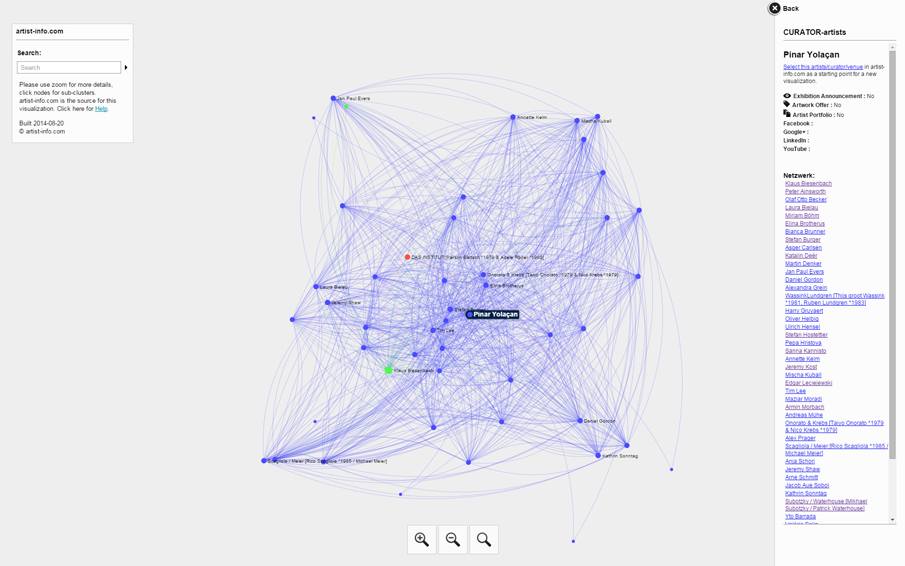
Selecting the artist Pinar Yolaçan shows all related artists and removes all other artists. It shows that there is a separate, specific group of artists connected through blue edges which has no connection to the other sub-clusters.
All exhibitions of Pinar Yolaçan in artist-info database and his many more connections displays his artist-info page.
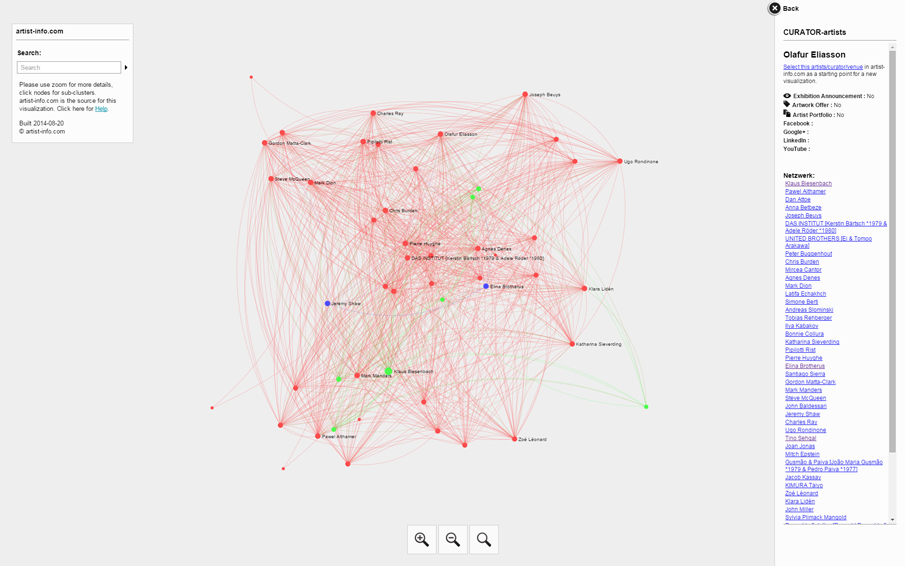
The same result for Olafur Eliasson. Selecting him shows all related artists and removes all other artists connected this time with red edges and showing that there is a separate, specific group of artists as a sub-cluster of 94 artists of Klaus Biesenbach’s shows. Only a few artists of the green colored cluster are among Olafur Eliasson’s sub-cluster.
All exhibitions of Olafur Eliasson in artist-info database and his many more connections shows his artist-info page.
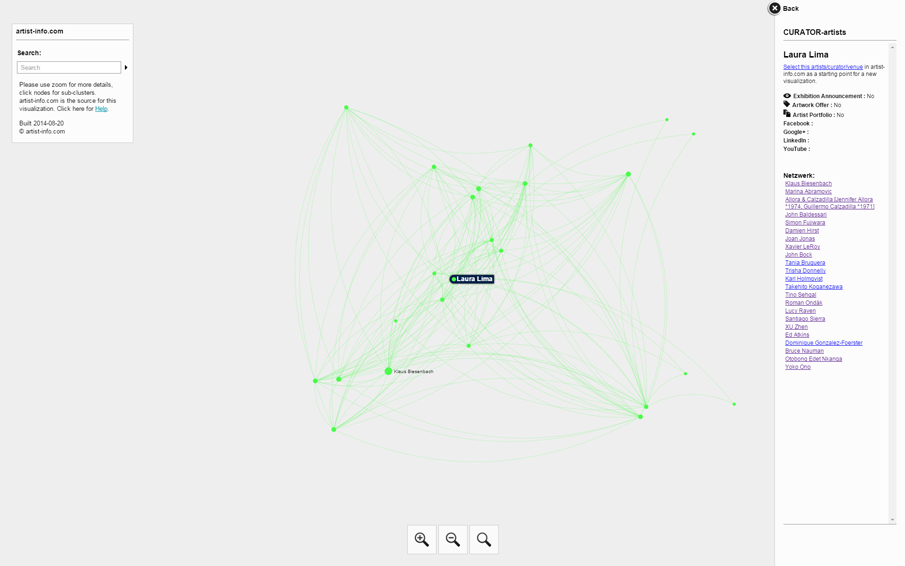
Selecting Laura Lima filters out all the artists connected with green edges showing their specific relation and neighborhood with no connection to the other sub-clusters.
All exhibitions of Laura Lima in artist-info database and his many more connections shows her artist-info page.
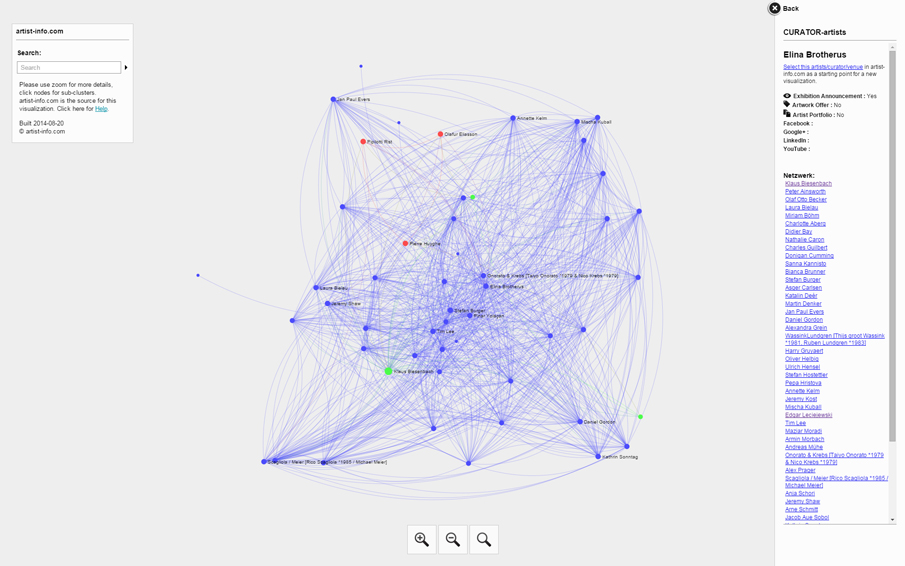
Elina Brotherus is another good example how very much the curator was focusing on a certain selection of artists and including only a few artists from his other artist sub-clusters.
All exhibitions of Elina Brotherus in artist-info database and her many more connections shows her artist-info page.

Last example is Marina Abramović showing how the sub-cluster with green edges and the cluster with red edges are blending into each other and showing the existing neighborhood of the curator’s different sub-clusters of artists.
All exhibitions of Marina Abramovic in artist-info database and her many more connections shows her artist-info page.
Benefits
This CURATOR-artists insight can be created for each of the 4.800+ curators in artist-info database.
A curator might work for one specific or different exhibition places, or for different exhibition projects. Her or his source is always the network of artists their work is based on.
 LANDSCAPE – Different from a simple list of names artist-info ‘Visualizing Art Networks’ transforms this list into to a landscape of clusters showing groups of artists connected among each other through exhibitions they had at many exhibition places and showing the curator’s preferences.
LANDSCAPE – Different from a simple list of names artist-info ‘Visualizing Art Networks’ transforms this list into to a landscape of clusters showing groups of artists connected among each other through exhibitions they had at many exhibition places and showing the curator’s preferences.
 CURATOR’S PROFILE – The artists building these clusters and sub-clusters reveal this curator’s choice and favorites. They help to find out more about the curator’s profile as well as to further develop it.
CURATOR’S PROFILE – The artists building these clusters and sub-clusters reveal this curator’s choice and favorites. They help to find out more about the curator’s profile as well as to further develop it.
 NEIGHBORHOOD – The different clusters make it possible to see how artists with their work might have something in common which led to such a group. This helps to identify a single artist’s profile as well as a specific aspect in their work which units them.
NEIGHBORHOOD – The different clusters make it possible to see how artists with their work might have something in common which led to such a group. This helps to identify a single artist’s profile as well as a specific aspect in their work which units them.
 GET INSPIRED – Showing the other artists in the neighborhood and the way they are connected to the CENTER is an important source for possible new exhibitions.
GET INSPIRED – Showing the other artists in the neighborhood and the way they are connected to the CENTER is an important source for possible new exhibitions.
Second important information for new associations are the artists selected by artist-info’s propagation algorithm and displayed as single points around the basic network image.
To go back to the starting image click on ‘Klaus Biesenbach’ and then on ‘Back’ at top of the right side pane.
Support
More details and how to use or customize Visualizing Art Networks for your project can be found on artist-info Help page / VISUALIZATION.

